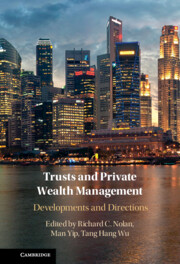Book contents
- Trusts and Private Wealth Management
- Trusts and Private Wealth Management
- Copyright page
- Contents
- Contributors
- Table of Cases
- Table of Legislation
- 1 Introduction
- 2 Family Trusts Today
- Part I The Rise of Asian Wealth
- Part II The Changing Legal Context
- 9 Trusts of Cryptoassets
- 10 Pragmatic Modernisation? Judicial Directions in Trusts and Wealth Management
- 11 Decision-Making in Trusts
- 12 Trustee Decision-Making in the Australian Superannuation Context
- 13 Trusts and UWOs
- 14 Constructive Trusts on Express Trusts
- 15 Abuse of Trust
- Index
11 - Decision-Making in Trusts
Applying Wednesbury Reasonableness after Braganza
from Part II - The Changing Legal Context
Published online by Cambridge University Press: 08 December 2022
- Trusts and Private Wealth Management
- Trusts and Private Wealth Management
- Copyright page
- Contents
- Contributors
- Table of Cases
- Table of Legislation
- 1 Introduction
- 2 Family Trusts Today
- Part I The Rise of Asian Wealth
- Part II The Changing Legal Context
- 9 Trusts of Cryptoassets
- 10 Pragmatic Modernisation? Judicial Directions in Trusts and Wealth Management
- 11 Decision-Making in Trusts
- 12 Trustee Decision-Making in the Australian Superannuation Context
- 13 Trusts and UWOs
- 14 Constructive Trusts on Express Trusts
- 15 Abuse of Trust
- Index
Summary
Decisions made by trustees and third parties (e.g. employers, actuaries, protectors) in relation to trusts are important. The decision-maker will want to get it right and others may look to the courts to review the decision. Generally, such decision-making powers are not ‘absolute’ but are subject to some limited review by the courts (whether or not being exercised by a fiduciary). Although not a trust case, Braganza [2015] UKSC 17 in the UK Supreme Court marks what looks likely to be a definitive shift in favour of applying public law Wednesbury reasonableness (or rationality) standards in both limbs (due consideration and perversity) to review many trust-related decisions. This is despite indications to the contrary in some previous cases, including Pitt v. Holt [2013] UKSC 26. The Braganza tests are in addition to review tests based on scope, proper purposes, honesty and (for fiduciary powers) unauthorised conflicts of interest. This chapter looks at the implications of Braganza and Wednesbury, mainly for trustees, but also of relevance for other decision-makers under a trust, including employers and protectors.
- Type
- Chapter
- Information
- Trusts and Private Wealth ManagementDevelopments and Directions, pp. 199 - 220Publisher: Cambridge University PressPrint publication year: 2022



